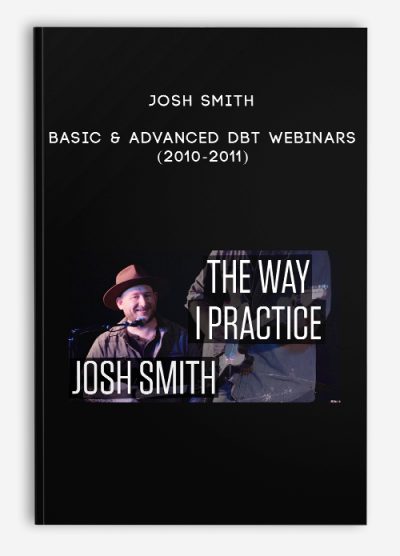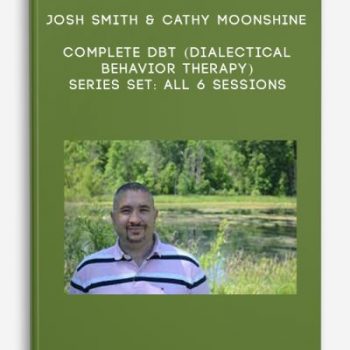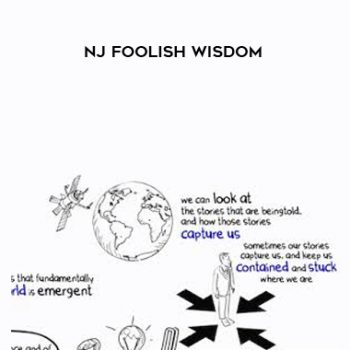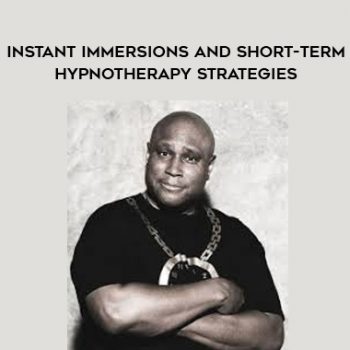
Josh Smith – Basic & Advanced DBT Webinars (2010-2011)
Description:
[3 MP4] [3 TXT]DBT is a multi-modal treatment. Although skills training is a single mode, it is by far the most popular mode of DBT. Many programs begin implementing this mode in the beginning of learning how to develop their DBT program. Perfect for support staff, those working on the front lines and for direct care clinicians, this training will primarily focus on the concepts and the foundation of the DBT skills while at the same time helping those clinicians experienced in DBT expand their knowledge in them. Participants who attend this training can also expect to learn how to structure and format a skills training group, understand the roles and functions of facilitators, begin to teach the concepts of the DBT skills, identify and confront specific therapy-destroying behaviors found in group, lead meaningful mindfulness exercises, and assign specific homework assignments to help strengthen skill generalization. National speaker and consultant Josh Smith will provide numerous case examples, recordings of sessions, and mindfulness exercises to demonstrate the concepts behind the DBT skills. He prides himself on being able to demystify the most difficult concepts in DBT into a way that helps people to leave with a better understanding. Josh is also well known for having a down-to- earth presentation style while balancing it with irreverence and reciprocityobjectives: Learn how to format and structure a DBT Skills Group. Describe the 4 Modules of DBT Skills Training: Core Mindfulness, Distress Tolerance, Interpersonal Effectiveness and Emotion Regulation. Identify specific therapy destroying behaviors found in group therapy. Explain the roles and functions of facilitators. Employ powerful mindfulness based techniques.
Outline:Structure and Format of DBT Skills Training Group Demographics and rules Length of group Mindfulness exercises Targets of skills training group Roles of skills trainers Homework review What to teach and when to teach it Roles and functions of facilitators Core Mindfulness Skills Becoming aware in order to act wisely Participating with a non-judgmental stance Letting go of fair vs. unfair, right vs. wrong, anger and vengeance Distress Tolerance Skills Learning to tolerate and accept the crisis as it is IMPROVE the moment Soothing the senses Interpersonal Effectiveness Skills Assertiveness training Maintaining and improving relationships Increasing self-respect Emotion Regulation Skills Reducing emotional vulnerability Enhancing positive emotions through experience Decreasing aversive emotions with opposite actionRunning Time 6 Hours 13 Minutes Josh Smith – DBT Skills Training Webinar (2011) This seminar recording is designed to help you learn how to teach the concepts of DBT skills to your clients along with how to format and structure a DBT skills training group. End this seminar recording feeling empowered and motivated to help your difficult to treat population!objectives: Identify the 5 modes and functions of DBT Identify the roles and responsibilities of DBT skills trainers Learn how to format and structure a DBT skills training group Identify the behavioral targets in DBT skills training group Teach at least one skill per module Identify the 4 modules of DBT skills training: Core Mindfulness, Distress Tolerance, Interpersonal Effectiveness and Emotion Regulation
Outline:History and Research on DBTModes and Functions of DBT Individual Therapy…Enhancing the client’s motivation Skills Training…Enhancing our client’s skill in order to change Telephone Consultation…Generalizing the skills in their environment Consultation Team…Enhancing the skill and motivation of the therapist Controlled Ancillary Providers…Structuring the treatment environment
DBT Skills Training Group Structure, format, rules and demographics
The diary card Roles of skills trainers
Behavioral Targets…what, when and how to treat behaviors in group Order of modules
How to conduct homework review
Core Mindfulness Skills Wise Mind…Getting clients to act intuitively The “What Skills”…observe, describe, participate The “How Skills”…Non-judgmental stance, onemindful, effectivenessDistress Tolerance Skills Distract with wise mind ACCEPTS IMPROVE the moment Self-soothe Evaluating pros and cons Radical acceptance
Interpersonal Effectiveness Skills objective Effectiveness: DEAR MAN Keep Relationship Effective: GIVE Self-Respect Effective: FASTEmotion Regulation Skills Reduce Vulnerability: PLEASE Build mastery Build positive experiences Opposite to emotion actionWrap -Up and ReviewRunning Time 5 Hours 42 Minutes Advance Dialectical Behavior Therapy, Beyond the Basics Webinar (2011)d Dialectical Description:
Take your current knowledge of DBT to the next level. This training will help you focus on individual DBT techniques, specifically the behavioral chain analysis. Many DBT clinicians agree that the individual mode of DBT is the most difficult mode to implement. This training will help you add another tool to your DBT tool belt and increase your confidence while delivering this comprehensive model. Come ready to engage in this highly interactive seminar. National expert and speaker Josh Smith will use case examples, recordings of actual sessions, role-plays and an up-beat, high energy and down-to-earth presentation to teach these advanced topics. Josh has the unique ability to translate the most challenging concepts from DBT to simple practical terms, so you are ready to use these skills the next day with your clientsobjectives: Describe the dialectical strategies used in DBT. Identify communication strategies used in DBT. Apply a behavioral chain analysis on specific target behaviors. Implement six levels of validation. Structure an individual session based on stage 1 target behavior.
Outline:Movement, Speed, Flow and Dialectics “Entering the Paradox” Using metaphors Playing “the Devil’s Advocate” Extending “Activating Wise Mind” “Making Lemonade out of Lemons” “Allowing Natural Change” Communication /Stylistic Strategies Reciprocal Communication—Being responsive, genuine and engaging Irreverent Communication—“Plunging in where angels fear to tread” Stages and Targets of DBT— Structuring the Treatment Pre-Treatment Stage: Orienting the client to treatment and getting commitment Stage 1 Target Behaviors: Decrease Life-Threatening, Therapy Interfering and Quality-of- Life Interfering Behaviors and Increase DBT Skills Stage 2 Target Behavior: Decrease Posttraumatic Stress Responses Stage 3 Target Behavior: Increase Self-Respect and Achieve Individual Goals Stage 4 Target Behavior: Increase joy, freedom and spiritual fulfillment Targeting Strategies—What to treat and when The Diary Card How to teach a client to fill out a diary card How to review a diary card in an individual therapy session Where to look for and what to treat on a diary card Handling diary card non-compliance The Behavioral Chain Analysis —The ingenuity of DBT Learning the steps to conduct the chain Identifying function in behavior Using behavioral principles in order to “break the chain” Applied case studies Core DBT Strategies: Validation Levels of Validation—Staying awake to Radical Genuineness Emotional Validation Strategies Behavioral Validation Strategies Cognitive Validation Strategies
NLP online course
So what is NLP?
Firstly, NLP stands for Neuro-Linguistic Programming. Secondly neuro refers to your neurology;
Thirdly linguistic refers to language however, programming refers to how that neural language functions.
As a result,In other words, learning NLP is like learning the language of your own mind!
Moreover, NLP is the study of excellent communication–both with yourself, and with others.
It was developed by modeling excellent communicators and therapists who got results with their clients.
NLP is a set of tools and techniques, but it is so much more than that.
In conclusion, It is an attitude and a methodology of knowing how to achieve your goals and get results.













tristian –
This is Digital Download service, the course is available at flixcourse.com and Email download delivery.